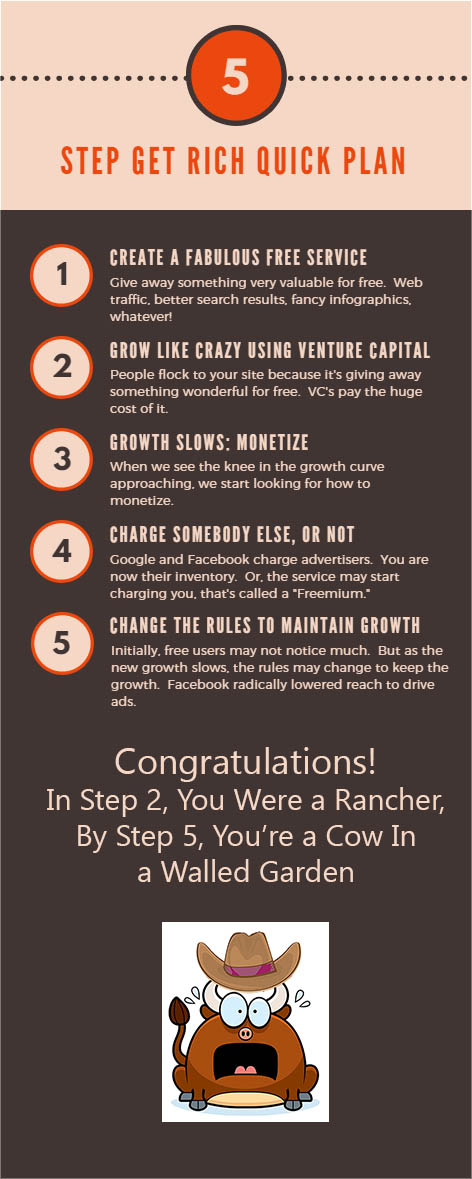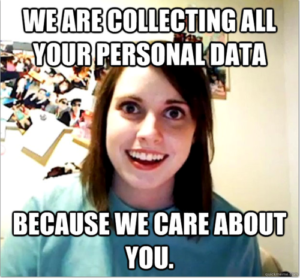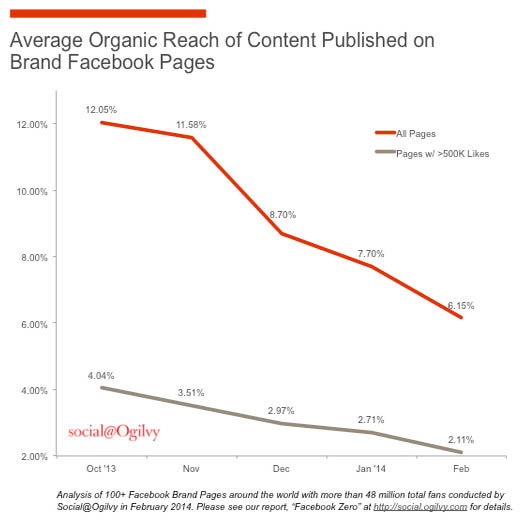
Are you the cow or the rancher?
What if you went to sleep one night, secure in the knowledge you’re a successful rancher, only to wake up the next morning realizing you’re just a cow on somebody else’s ranch?
That would be a very shocking realization on all kinds of levels, yet it happens all the time in the wild wild west world of Web Services.
What do I mean by Web Services?
It’s an intentionally vague term that applies to all sorts of things:
- The service you use to host your web site.
- Facebook, Twitter, LinkedIn, YouTube, Instagram, Snapchat, and a whole host of other social media. You may be using them for anything from hosting your web presence to driving traffic to your web presence and all points in between.
- WordPress.com is a web service because they give you everything from soup to nuts. But WordPress.org is just software and not a service. Confusing, right?
- Web sit creators including Squarespace, Wix, and many more.
- A whole host of niche services such as shopping carts and checkout services like Shopify and Samcart. Page (and even web site) creators like Leadpages or Clickfunnels. And many more.
- Domain parking services such as GoDaddy and many more.
- Internet Service Providers give you access to the Internet in some form or fashion.
By now, you’re probably realizing that you are dependent on at least some of these web services. It’s almost impossible not to depend on a web service of some kind. At the very least you use a domain hosting service and an Internet Service Provider so that the server in the corner of your office that does everything else has a presence on the Internet.
What’s All This “Rancher” Versus “Cattle” Business?
There was this fancy term “disintermediation” that was coined back in the original dot com era. Wikipedia defines it thus:
Disintermediation is the removal of intermediaries in economics from a supply chain, or cutting out the middlemen in connection with a transaction or a series of transactions.
Originally, it referred to the ability of the Internet to bring consumers something directly by literally cutting out the middlemen. Why use retail to sell your product if you could go directly to your customers?
But, over time, Internet Entrepreneurs became extremely clever about gaining control. Here’s the classic business model they developed and have been following since Google and before:

5 Step Business Plan for Profitting From a Walled Garden…
Let’s dig into this classic 5 step plan.
Step 1: You create a free service offering fabulous value.

People pile on like crazy because it’s free.
Examples:
- Google offered the world’s best search engine for free.
- Facebook offered free social media–a way to connect with your friends.
- Dropbox offered a way to share files across machines.
- Medium offered a better blogging platform. It’s prettier than WordPress (for most), it’s easier to use, and it brings you traffic to your blog posts.
- Gmail gives you free email.
The list goes on and new services like this are being created constantly.
Incidentally, the service doesn’t have to be free. SaaS and Cloud companies offer services that are cheap because they are paid monthly or annually instead of up front like a software license.
Step 2: Grow like crazy using Venture Capital.

The Venture Capital is that invisible guy behind the all powerful Wizard of Oz. You don’t really know it’s there, but it is pumping in the millions of dollars needed to keep the lights on while the fabulous free service grows.
You don’t see the invisible guy, you see the Founders who are the public face of the company. But, the investors are ultimately in control and they’re in it for the money. Even in cases where the Founders retain literal control, they wind up with similar motives because the stock market will still hold their toes to the fire.
Step 3: Growth Slows – Monetize!

Google grew for a time having no idea how it was ever going to make money. So did Twitter and many others. But, ultimately a scheme must be devised to “Monetize” the service. This needs to happen when we can start to see the knee in the growth curve approaching.
All these free services eventually slow their growth rate. The world is finite and there are only so many free users to tap into. Once it gets harder to grab them fast enough for that exponential growth, it’s time to monetize.
The VC’s behind that green curtain will make sure monetization happens one way or the other.
Step 4: Charge Somebody Else, Or Not

In the best scenarios, we get to keep giving the service away for free and growing like crazy because we find somebody else to charge. That’s the advertising model, and in that case, you go from being the “customer” (which you never were, it’s a free service, silly!) to the “inventory”. They’re selling you to their advertisers. Or, for example, eBay, which hugely tilted the system to favor sellers because they were the ones paying the bills.
That’s one way you go from being Rancher to Cow–the Cows are the Inventory on a Ranch.
Though you’re now inventory, the service will attempt to make you feel you are the customer:
We are collecting all your personal data because we care about you.
It can also happen that the firm doesn’t find someone else to pay, in which case they need to start charging you. That’s called “Freemium” service. Typically, the original leeways and latitudes start to get limited and you need to pay for a (initially) very inexpensive plan to get the extra features you need.
Step 5: Change the Rules to Maintain Growth
This is where it gets ugly. The growth Gods must be served. By this stage, if everything is working properly, the Stock Market has put a huge valuation on the firm based on its growth. But, inevitably, that growth must slow. There just aren’t enough new customers once the company is big enough.
But, there’s one last trick to be played (and this is why I say it gets ugly)–the company can change the rules.
We’ve seen this happen countless times, but let me give a concrete example with Facebook.
Folks who got in building their audience on Facebook in the early days profited hugely. The site was so viral it made growing an audience massively easier for such folks. But then it came time for Facebook to become more profitable and the picture changed. Here’s a graph showing the decline of organic reach for content published on Facebook between October 2013 and February 2014:

Epic decline in Facebook reach per Ogilvy…
Now let’s imagine we were marketers who had enjoyed the early success of Facebook and so bet everything we had on the platform. Suddenly, our web traffic plummets to half what it was over a short 4-month period.
I’d be climbing the walls trying to figure out what I was doing wrong, wouldn’t you?
Yet, eventually we would realize we hadn’t done anything wrong at all. Facebook simply changed the rules on us, without warning.
Now, fast forward to today. BTW, Facebook has continued reducing reach in the years since that graph was published. But, of course, everyone has some new platform they want to bet everything on. I hear a lot about Instagram, for example. Here’s a great quote on that from Convince and Convert:
Let’s remember that Facebook OWNS Instagram, and if you think they aren’t going to eventually pull the EXACT same move on Instagram you are naive.
I’ve got to agree.
Even SocialMedia experts are not immune. Buffer, which makes the popular Social Media re-posting software I use, admitted they’d lost nearly half their Social Media Traffic in just 12 months. If this sort of thing can happen to Buffer, it can happen to anyone.
Recently I was engaged in a back and forth with a Medium author who was advising everyone to forget blogging and put everything into Medium. She likened blogs to being like Blockbuster video–inevitably it was abandoned and everyone went to Netflix. Of course the Blogs were playing the role of Blockbuster–going away soon to be replaced by the likes of Medium. The article is brilliantly written from the standpoint of linkbait and she is very popular on Medium.
But she’s also totally wrong.
She felt there was no downside to writing everything on Medium. As she put it:
“You still own your work. If Medium goes away, move it somewhere else.”
Here’s what I wrote back:
Shaunta, you’ve put your finger right on the problem Paul Zanetti and I are trying to explain.
You don’t own a significant piece of the asset, the platform does.
You don’t own your followers on Medium and there is no way to move them somewhere else if it goes under. OTOH, that clunky backward Mailchimp route? You do own those followers if they signed up for your weekly blog newsletter. And you can have them follow you anywhere you like, or at least you have a way to try to get them to follow.
All those myriad things the Medium algorithms considered in order to send you all the traffic you’ve gotten? Things like how many Followers you have, how many folks recommend the article, how many read it through, and all that jazz? Nope. You don’t own that either, darn it.
And what about those nice partners who republished your stuff on Medium and drove your views even higher? Sorry, that’s also not something you own. If you’re lucky, they’re already reposting on a non-Medium property, but if not, they’re going to be out in the cold just like you if it goes under or changes its behavior in unhappy ways.
In short, you own very little of what is creating value for you here inside this Walled Garden called “Medium.” You can try moving all your articles to a blog and seeing how much traffic you get if you don’t believe me.
There are others who’ve reported on what happens with Medium, Quora, Facebook, and other such platforms when either the rules changed or they investigated how much it was helping their actual blog and web sites.
Relying 100% on Medium is not only unnecessary, but it’s also not a pretty picture in the long run.
Why did I say it is unnecessary to rely on Medium?
Because you can run your blog, own it, and still republish all your content on Medium to attract whatever traffic you can there. That’s exactly what I do here with BobWarfield.com. No harm, no foul.
Incidentally, not long after I wrote that response to Shaunta, which I didn’t get the impression she bought, I came across an article decrying recent changes in Medium. Yes Virginia–they’re changing the rules as part of the standard game plan these companies always follow.
By now I hope I’ve convinced you that some platforms can be dangerous to your business long term. But they’re not all bad.
2 Simple Rules To Know If a Platform Is Good Or Bad (Primary or Secondary)
Look, choosing the right web platforms can save you a lot of time and money. They can really accelerate your growth. The choose is knowing which platforms are good or bad. But in fact, I prefer to think of them as primary and secondary.
A primary platform is one you bet your business on. A secondary platform is one that you may use, but it’s a nice to have. You’re not putting the bulk of the value you create into a secondary platform, so if it goes away or changes too much, your business will do fine.
I have a few rules for how to go about distinguishing to make it easy for you to know which is which.
Rule #1: You Own the URL
If you own the URL, then you own the means of identifying and visiting the asset on the Internet. That means all the lovely links and bookmarks out there that build up over time are protected and can’t just disappear or go to work for someone else over night. Yes, individual links and bookmarks may change, but there’s no one way this happens at once.
Let’s try a few examples:
- Medium loses on this rule. They own the URL. The equity from all the bookmarks and links is going into their pocket, not yours.
- Same with a Facebook Group, YouTube channel, or Instagram page. You don’t own those URL’s.
- LIkewise, if you have a choice of using a service like Clickfunnels, you can plug it into your web site as a subdomain (something like funnels.bobwarfield.com) and you’re good, you own that URL. But if you leave it in their hands (bobwarfield.clickfunnels.com) then they own the URL. This is why it’s worth checking whether you can get your own domain in their or not on any web service you consider.
Let me give you the three major reasons why you must own your URL’s:
- URL’s live forever. All those bookmarks, links on social media, links in emails, and everywhere else are an asset that builds over the lifetime of your URL. Every time you change the URL, you run the risk of losing all that value.
- SEO Algorithms: Yes, they look a the URL. Suppose you’re using a service where you dont own the URL and Google decides mostly spammy people use that service. So they penalize all of those URL’s.
- Email Algorithms: Very similar story here. We live in a world where algorithms are deciding what we see or don’t see. Again, what if GMail decides a certain kind of URL is always spam or always a promotion?
These kinds of reasons are only going to multiply over time. Serious stuff!
RULE #2: YOU OWN THE CONTENT And can migrate it elsewhere
For the sake of argument, let’s suppose Medium allowed you to create your own vanity domain, much the way WordPress.com does. I could then launch BobWarfield.com on Medium, own the URL, and life is good, right?
Well, maybe.
Your next question is whether you own the content and can migrate it elsewhere.
Say you get tired of Medium, they’ve started charging you a lot to host there, and you want to move to a cheaper alternative. But, when you decide to try to do that, you discover one or more of these problems:
- There’s no way to export all the content easily. Sure, you can go in and cut and paste each individual article and image, but that’s not really very practical once your web presence reaches a certain size.
- Your legal agreement with the platform states that they own your content in some way. Perhaps you can migrate it, but they get to keep a copy or some such. You can see where that might get sticky. Worth reading the fine print there!
- There’s an export available, but the service gives you your data in a proprietary format that’s just not useful anywhere else. This can get really complicated and hard to envision.
For example, suppose the service does something more complex than just content. For example, suppose we’re talking about a service for creating Cloud Software. You write software on it, it works great, but one day you want to export that software so you can run it in a different Cloud. However, the language they use only runs in the one Cloud and not in others. So, you are stuck. You’d have to completely rewrite that software to migrate it to a new Cloud.
A similar example is a mobile app. Runs great on iPhones but needs to be rewritten for Android. But it gets worse. Unless you jailbreak the iPhone, you can move your iPhone app out of the App Store, but nobody can install it if you do.
Some pretty sneaky stuff to be aware of there, eh?
What Else to Look For In a Web Service?
You can go far and avoid a lot of problems with just those two rules, but there’s one more consideration I like to bring up, and that is the size of the ecosystem that supports the service. The ecosystem consists of customers and 3rd parties that enhance the service in some way. They could be creating plug-ins or apps, doing training, writing books to help you, offering theme customization, or almost any of that jazz. It’s all good, it adds value, and you might need it some day.
Before I adopt a Service, I always try to check:
- What is its relative popularity to its competitors? Maybe it’s awesome, but do I really need the 18th most popular email vendor vs one of the top 10?
- How easy is it to get help on the web? Google around and even just assess how easy it is to find reviews and tutorials. You’ll get a sense.
- If I need to hire someone to work with this thing, either because I can’t or I’m too busy, are there enough folks offering such service?
- Is the service customizable–are there API’s, plugins, apps, themes, and that sort of thing? For simple services, it may not matter. But complex services often need customization.
OK, that’s a good set of tools to help you avoid the obvious Web Service traps.
If this article resonated and you'd like more just like it, sign up for our Entrepreneur's Newsletter. You'll receive a free mini-course Work Smarter and Get Things Done. It teaches you how to maximize your productivity so you can get everything you need to do for your business done. It even includes our free productivity software to get you organized, focused, and productive.
So super helpful information.. so excited to be signed up.. so my wife has recently started an online bunisess and is hosting on Squarespace.. you mentioned it as a service but didn’t critique specifically.. we purchased the domain but my assumption is that it is a scenario where the content is difficult or impossible to port if something changes and need arises.. for non programmer types (us) how would you go about controlling the content (rancher). I didn’t build her first business site using a wysiwyg software from adobe but it was a pretty flat site.. not much artistic or flare just functional. The services provided by the canned places are kind of helpful with payment and mailchiml integration without the need to know how to code all of that.. thoughts recommendations.. is it reasonable to start off as a cow and grow into affording to be a rancher? Trying hard to make sure the URL’s and data is owned and forever..
Thank you for sharing your experience and thoughts!! Appreciated.. and not surprising… I am originally connected thru your cncblog (love it) and own your software (wizzard and editor) awesome stuff and you got me started in CNC!!
I put my wife’s site below as I don’t have my own..
Zak, Squarespace is okay, more of a rancher situation. I wouldn’t start off a cow and hope to grow to a rancher. The problem is you’re trying to get your SEO traffic started. It’s the #1 traffic source (see my Top 10 Marketing Master series to see–it’s #1 for all of them and for me). But, it takes time, and only works if you’re a rancher. The clock to start your SEO success doesn’t start until you have a rancher site. It will never begin with a cow site.
Sorry should have said “did build her first site”
Great stuff. You might want to consider a further step. We’ve got plenty of time to avoid fracturing the Internet but this game of rancher to cow has another level to it. DNS is under new management so your ownership of any particular URL is no longer ultimately managed by an institution with respect for property rights encoded in its DNA.
This is starting to show up in deplatforming efforts for extremists but is unlikely to remain there. The next bright young thing who comes up with the successor to the Obama administration’s Operation Chokehold is unlikely to ignore the potential for deregistering domain names.